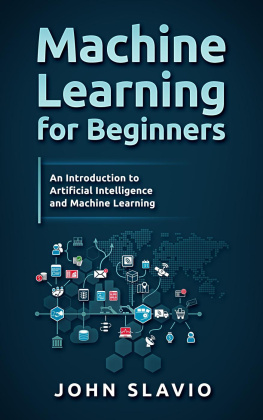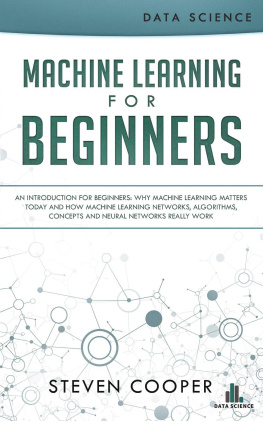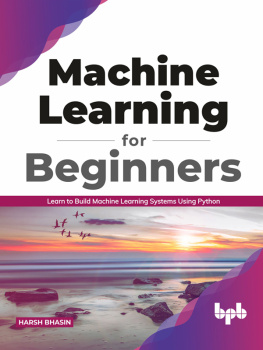Theobald - Machine Learning for Absolute Beginners
Here you can read online Theobald - Machine Learning for Absolute Beginners full text of the book (entire story) in english for free. Download pdf and epub, get meaning, cover and reviews about this ebook. year: 2017, genre: Politics. Description of the work, (preface) as well as reviews are available. Best literature library LitArk.com created for fans of good reading and offers a wide selection of genres:
Romance novel
Science fiction
Adventure
Detective
Science
History
Home and family
Prose
Art
Politics
Computer
Non-fiction
Religion
Business
Children
Humor
Choose a favorite category and find really read worthwhile books. Enjoy immersion in the world of imagination, feel the emotions of the characters or learn something new for yourself, make an fascinating discovery.
Machine Learning for Absolute Beginners: summary, description and annotation
We offer to read an annotation, description, summary or preface (depends on what the author of the book "Machine Learning for Absolute Beginners" wrote himself). If you haven't found the necessary information about the book — write in the comments, we will try to find it.
Theobald: author's other books
Who wrote Machine Learning for Absolute Beginners? Find out the surname, the name of the author of the book and a list of all author's works by series.
Machine Learning for Absolute Beginners — read online for free the complete book (whole text) full work
Below is the text of the book, divided by pages. System saving the place of the last page read, allows you to conveniently read the book "Machine Learning for Absolute Beginners" online for free, without having to search again every time where you left off. Put a bookmark, and you can go to the page where you finished reading at any time.
Font size:
Interval:
Bookmark:
Machine Learning for Absolute Beginners
Oliver Theobald
First Edition
Copyright 2017 by Oliver Theobald
All rights reserved. No part of this publication may be reproduced, distributed, or transmitted in any form or by any means, including photocopying, recording, or other electronic or mechanical methods, without the prior written permission of the publisher, except in the case of brief quotations embodied in critical reviews and certain other non-commercial uses permitted by copyright law.
Contents Page
Introduction
Overview of Data Science
The Evolution of Data Science and the Information Age
Big Data
Machine Learning
Data Mining
Machine Learning Tools
Machine Learning Case Studies
Online Advertising
Googles Machine Learning
Machine Learning Techniques
Introduction
Regression
Support Vector Machine Algorithms
Artificial Neural Networks - Deep Learning
Clustering Algorithms
Descending Dimension Algorithms
Where to From Here
Career Opportunities in Machine Learning
Degrees & Certifications
Final Word
Its a Friday night at home and youve just ordered a pizza from Joes Pizzeria to be delivered to your house. The squeaky voice teen over the phone tells you that your pizza will arrive within 30 minutes.
But after hanging up the phone, you receive a message from your girlfriend (or boyfriend) asking if she/he can come over tonight.
Your girlfriend doesnt have a car, so you will have to drive over to her house and pick her up. While of course you want her to come over, you also dont want to wait until after the pizza has been delivered before you collect her - as the pizza will just sit there and get cold. You also dont want to pick her up after eating your pizza because then youll miss the football game live on TV.
You need to make a quick decision. The first question you need to ask yourself, is do you have enough time to pick up your girlfriend before the pizza arrives?
Remember that the pizza is estimated to arrive within 30 minutes. If you leave now, you should be back within 30-40 minutes. As you know the route to your girlfriends house, you can safely predict the journey time with a high degree of accuracy.
But just as youre about to walk out the door you realize theres another variable you havent considered. You realize that what you also need to predict, in addition to the journey time to pick up your girlfriend, is the timing of the pizza being delivered. This too is something you have less control over.
Joes Pizza is a popular pizzeria, and tonight also happens to be a Friday night. Theres thus a range of factors that could affect your pizza delivery, including how many other people are ordering pizza, and the navigation ability of the delivery guy.
These two variables both have the potential to delay the delivery time of your pizza. However, this is your first time ordering a pizza on a Friday night. Perhaps unaware to you, Joes Pizza has more delivery staff on call on Friday than say on a normal weeknight.
There are three potential methods to tackle this problem:
The first option is to apply existing knowledge. However you have no previous experience of ordering a pizza on a Friday night. Unfortunately theres also no app to calculate the average wait time on a Friday night for a pizza delivery in your area.
The second option is to ask someone else. You have exhausted this option already. The teenager on the other end of the phone at Joes Pizzeria has already told you that your pizza will arrive within 30 minutes.
The third option is to apply statistical modelling.
Given youve picked up this model on machine learning, lets go with the third option.
You think back to your previous experiences of ordering home delivery from Joes Pizzeria. You then apply this information to predict the likelihood of the pizza arriving at your house on time. If the expected time of delivery exceeds 30 minutes then you can justify your decision to collect your girlfriend and return home in time for the delivery guy to arrive with your pizza.
Lets assume you have previously ordered pizza on 8 occasions, and the delivery time was late by greater than 10 minutes on four occasions. This means that the pizza arrived on time, or was early to arrive 50 percent of the time. This also means that there is roughly a 50% chance that the pizza delivery will be late again tonight.
Your mental decision-making progress is not comfortable with anything less than 70% (that the pizza delivery will be late). You thus remain at home to receive the pizza and make up an excuse not to see your girlfriend tonight.
Using existing data to base your decision is known as the empirical method. The concept of empirical data-backed decision-making is integral to what is known as machine learning.
Machine learning concentrates on prediction based on already known properties learned from the data.
In this example of the pizza delivery, we only considered the attribute of "frequency," the frequency of previous late deliveries. Machine learning models though consider at least two factors.
One factor is the result you wish to predict, known as the dependent variable. In this example, the dependent variable is whether the pizza delivery will be significantly late (more than 10 minutes). The second factor is the independent variable, which again predicts whether the pizza will be late but on a different independent variable. Day of the week, for example, could be an independent variable.
It could be a case that in the past, when the pizza was delivered on a Monday night the delivery time qualified as late. This could be explained by the fact that Joes Pizza has less delivery drivers on call on Monday nights.
Based on your previous experience, and not withstanding the three late deliveries that occurred on Monday night, pizza deliveries from Joes Pizzeria typically arrive within the estimated time period.
This being the case, you could establish a model to simulate the probability that the pizza will arrive late based on whether or not it is a Monday night.
A decision tree can be used to map out this particular example.

We now see that under this modelling there is only a 25% chance of the pizza delivery being late.
The process is relatively simple when considering a single independent variable. It does however become more complicated to calculate once a second or third independent variable are added to the equation.
Let's now add rain as a third variable that could affect the pizza delivery time. A rainy night could of course slow down the delivery time due to safety precautions and extra traffic on the road.
This new variable is then added to the decision-making process. The new model now includes two independent variables in addition to one dependent variable.
We now need to predict the number of minutes the pizza will be late based on the level of rain (light = 2 minutes, moderate = 5 minutes, heavy = 15 minutes) and the day of the week. The predictions produced by this model will give us an idea on how late the pizza will be on any given day of the week. In this case though, a decision tree is of very little use as it can only predict discrete values (yes/no).
However, with the help of machine learning techniques you can apply the method of linear regression to predict the result.
Its now time to sit down at your computer. For the sake of the story lets forget the fact that your girlfriend is waiting for you to reply to her message.
Lets also turn our attention to discuss machines learning.
Next pageFont size:
Interval:
Bookmark:
Similar books «Machine Learning for Absolute Beginners»
Look at similar books to Machine Learning for Absolute Beginners. We have selected literature similar in name and meaning in the hope of providing readers with more options to find new, interesting, not yet read works.
Discussion, reviews of the book Machine Learning for Absolute Beginners and just readers' own opinions. Leave your comments, write what you think about the work, its meaning or the main characters. Specify what exactly you liked and what you didn't like, and why you think so.










